Journal of Southern Medical University ›› 2025, Vol. 45 ›› Issue (5): 986-994.doi: 10.12122/j.issn.1673-4254.2025.05.11
Previous Articles Next Articles
Xiaotao LIANG1( ), Yifan XIONG1, Xueqi LIU5, Xiaoshan LIANG4, Xiaoyu ZHU1, Wei XIE1,2,3,4(
), Yifan XIONG1, Xueqi LIU5, Xiaoshan LIANG4, Xiaoyu ZHU1, Wei XIE1,2,3,4( )
)
Received:2025-01-23
Online:2025-05-20
Published:2025-05-23
Contact:
Wei XIE
E-mail:1092296938@qq.com;xieweizn@126.com
About author:First author contact:LIANG Xiaotao1, XIONG Yifan1, LIU Xueqi5, LIANG Xiaoshan4, ZHU Xiaoyu1, XIE Wei1, 2, 3, 4
Xiaotao LIANG, Yifan XIONG, Xueqi LIU, Xiaoshan LIANG, Xiaoyu ZHU, Wei XIE. Huoxue Shufeng Granule alleviates central sensitization in chronic migraine mice via TLR4/NF-κB inflammatory pathway[J]. Journal of Southern Medical University, 2025, 45(5): 986-994.
Add to citation manager EndNote|Ris|BibTeX
URL: https://www.j-smu.com/EN/10.12122/j.issn.1673-4254.2025.05.11
| Primer name | Sequence |
|---|---|
| IFN-γ Forward | AGCAACAACATAAGCGTCATTGA |
| IFN-γ Reverse | TGACCTCAAACTTGGCAATACTC |
| TNF-α Forward | GCCTCCCTCTCATCAGTTCTATG |
| TNF-α Reverse | ACCTGGGAGTAGACAAGGTACAA |
| IL-1β Forward | GCAACTGTTCCTGAACTCAACT |
| IL-1β Reverse | ATCTTTTGGGGTCCGTCAACT |
| IL-6 Forward | ACAACCACGGCCTTCCCTACTT |
| IL-6 Reverse | CACGATTTCCCAGAGAACATGTG |
| GAPDH Forward | CAACTACATGGTCTACATGTTC |
| GAPDH Reverse | CTCGCTCCTGGAAGATG |
Tab.1 Primer sequences used in this study
| Primer name | Sequence |
|---|---|
| IFN-γ Forward | AGCAACAACATAAGCGTCATTGA |
| IFN-γ Reverse | TGACCTCAAACTTGGCAATACTC |
| TNF-α Forward | GCCTCCCTCTCATCAGTTCTATG |
| TNF-α Reverse | ACCTGGGAGTAGACAAGGTACAA |
| IL-1β Forward | GCAACTGTTCCTGAACTCAACT |
| IL-1β Reverse | ATCTTTTGGGGTCCGTCAACT |
| IL-6 Forward | ACAACCACGGCCTTCCCTACTT |
| IL-6 Reverse | CACGATTTCCCAGAGAACATGTG |
| GAPDH Forward | CAACTACATGGTCTACATGTTC |
| GAPDH Reverse | CTCGCTCCTGGAAGATG |
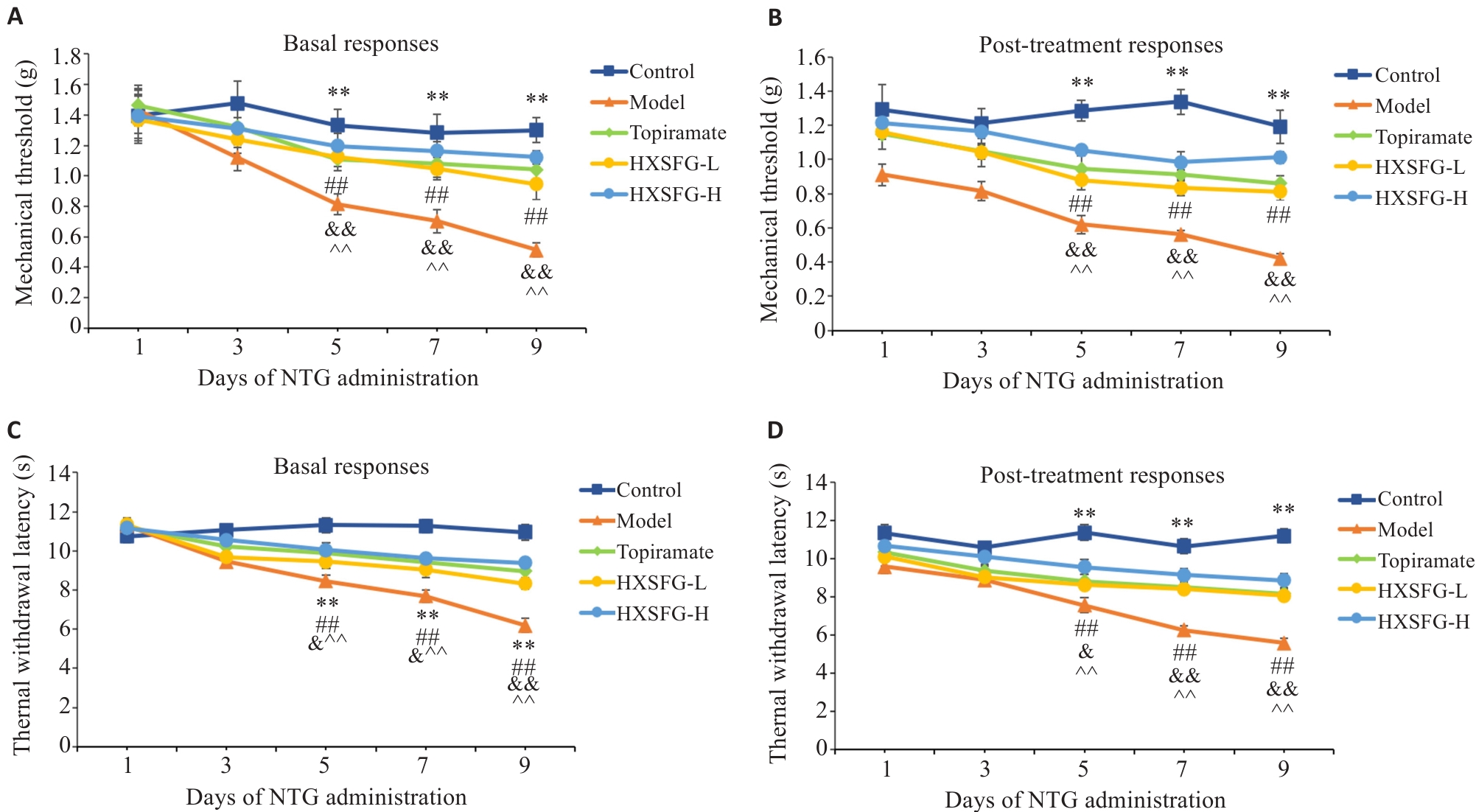
Fig.2 HXSFG alleviates baseline and acute mechanical and thermal hyperalgesia in mice with NTG-induced CM. A: Changes in baseline mechanical pain thresholds of the hind paws of the mice. B: Changes in acute mechanical pain thresholds of the hind paws of the mice. C: Changes in baseline thermal pain thresholds of the hind paws. D: Changes in acute thermal pain thresholds of the hind paws. Data are presented as Mean±SE (n=12). Statistical analysis was performed using two-way ANOVA followed by Tukey's post hoc test. **P<0.01 Model group vs Control group; #P<0.05, ##P<0.01 Topiramate group vs Model group; &P<0.05, &&P<0.01 HXSFG-L group vs Model group; ^^P<0.01 HXSFG-H group vs Model group.
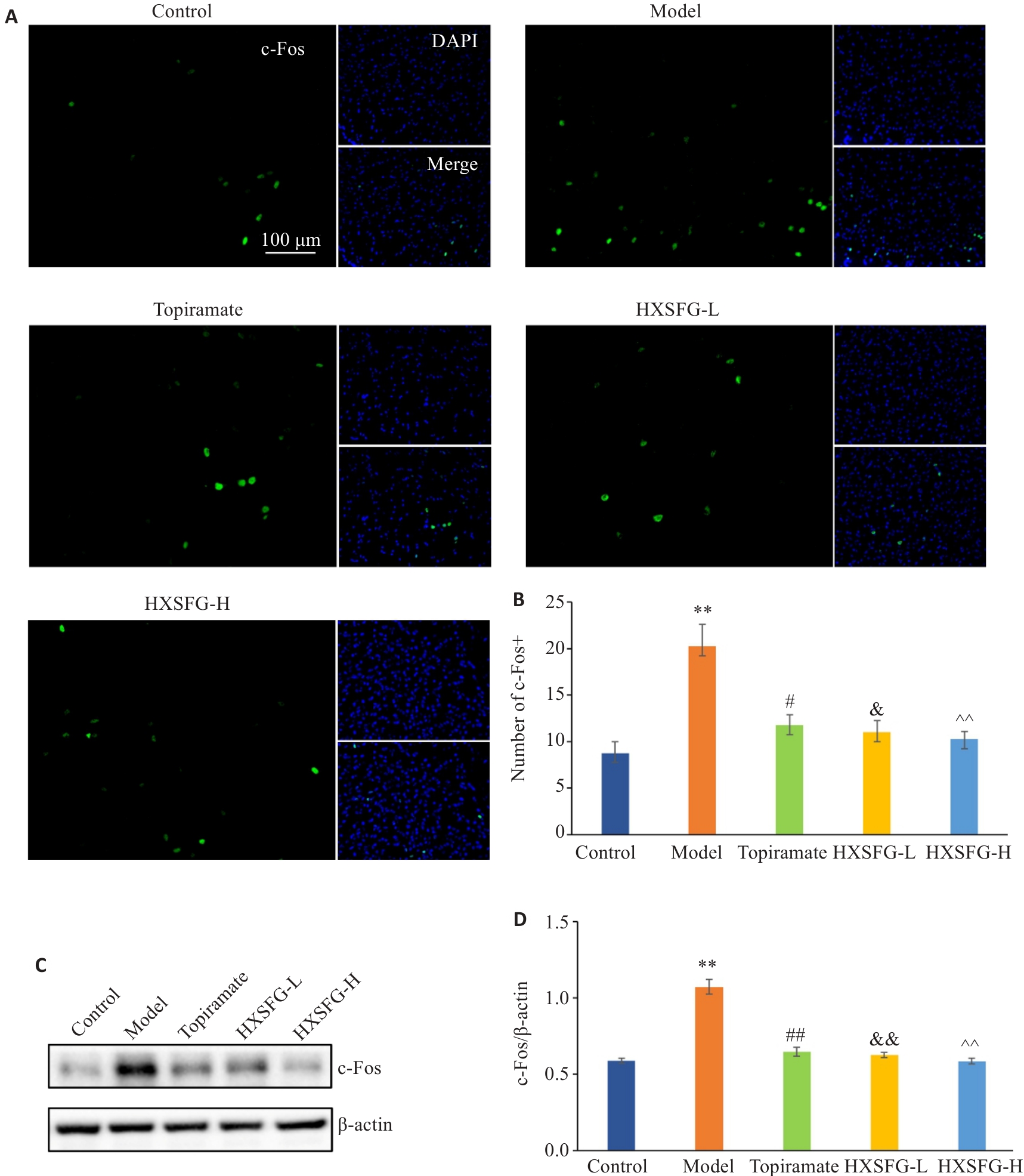
Fig.3 Effects of HXSFG on c-Fos expression levels in the TNC region of mice with NTG-induced CM. A: Immunofluorescence images of c-Fos expression (Scale bar: 100 μm). B: Quantitative analysis of c-Fos immunoreactivity (Each group included 4 mice, and 3 slices were analyzed for each mouse). C: Protein immunoblot images of c-Fos expression. D: Quantitative analysis of c-Fos protein immunoblotting (n=4). Data are presented as Mean±SE. Statistical analysis was performed using two-way ANOVA followed by Tukey's post hoc test. **P<0.01 vs Control group; #P<0.05, ##P<0.01 vs Model group; &P<0.05, &&P<0.01 vs Model group; ^^P<0.01 vs Model group.
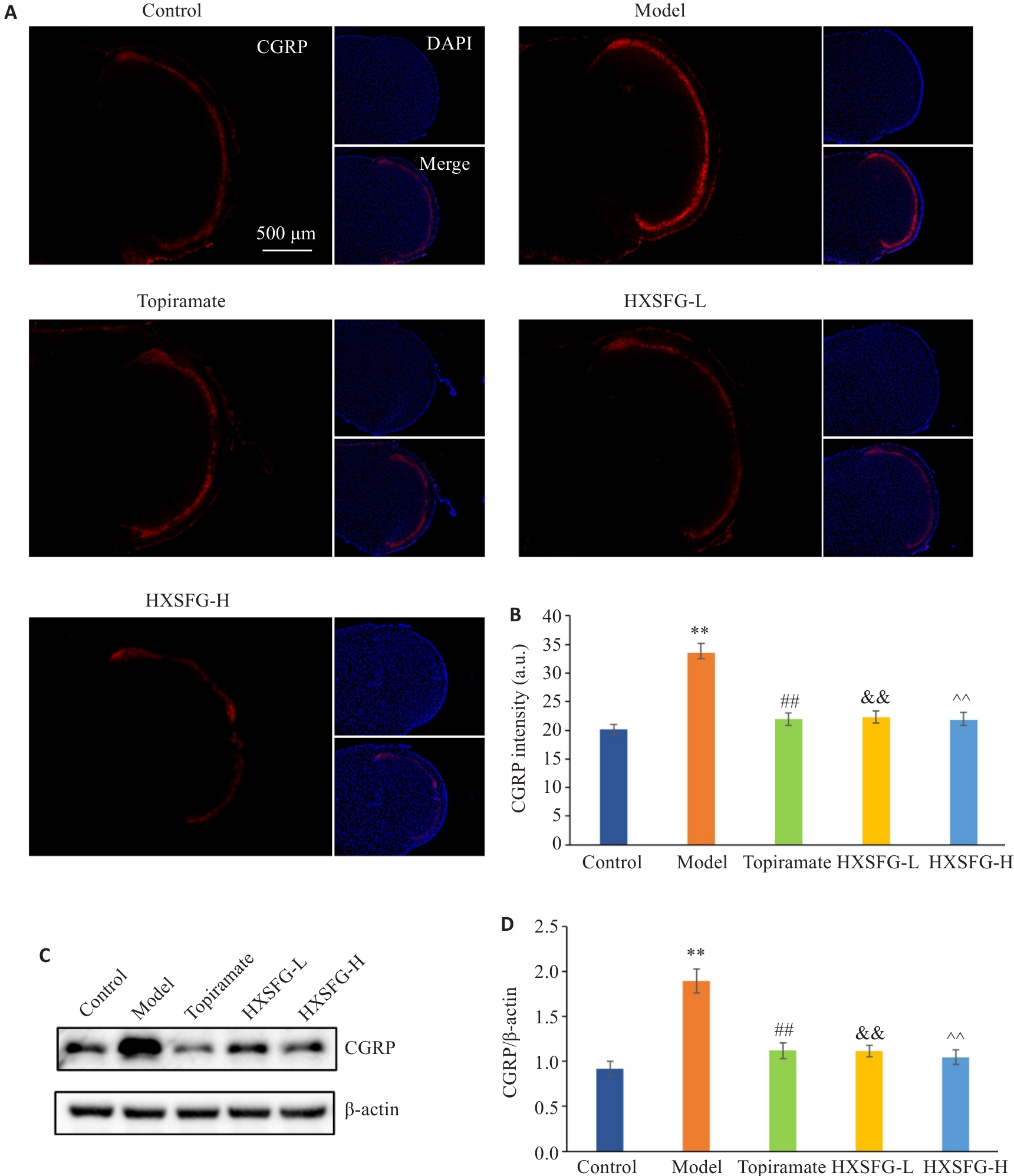
Fig.4 Effects of HXSFG on CGRP expression levels in the TNC region of mice with NTG-induced CM. A: Immunofluorescence images of CGRP expression (×40, scale bar: 500 μm). B: Quantitative analysis of CGRP immunoreactivity (Each group included 4 mice, and 3 slices were analyzed for each mouse). C: Protein immunoblot images of CGRP expression. D: Quantitative analysis of CGRP protein immunoblotting (n=4). Data are presented as Mean±SE. Statistical analysis was performed using two-way ANOVA followed by Tukey's post hoc test. **P<0.01 vs Control group; ##P<0.01 vs Model group; &&P<0.01 vs Model group; ^^P<0.01 vs Model group.
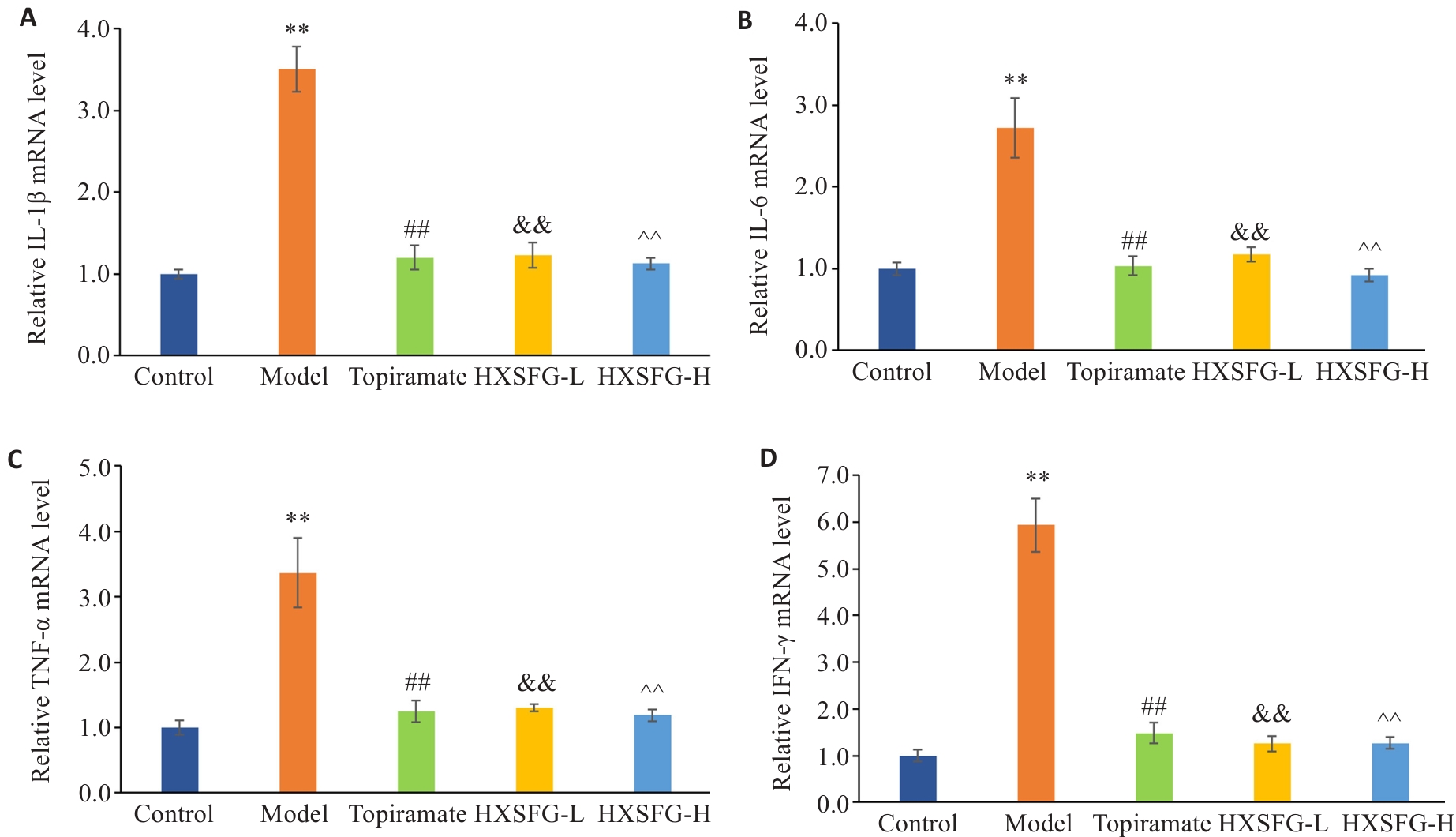
Fig.5 Effects of HXSFG on mRNA levels of inflammatory factors in the TNC region of mice with NTG-induced CM. A: Relative mRNA level of IL-1β. B: Relative mRNA level of IL-6. C: Relative mRNA level of TNF‑α. D: Relative mRNA level of IFN-γ. **P<0.01 vs Control group; ##P<0.01 vs Model group; &&P<0.01 vs Model group; ^^P<0.01 vs Model group.
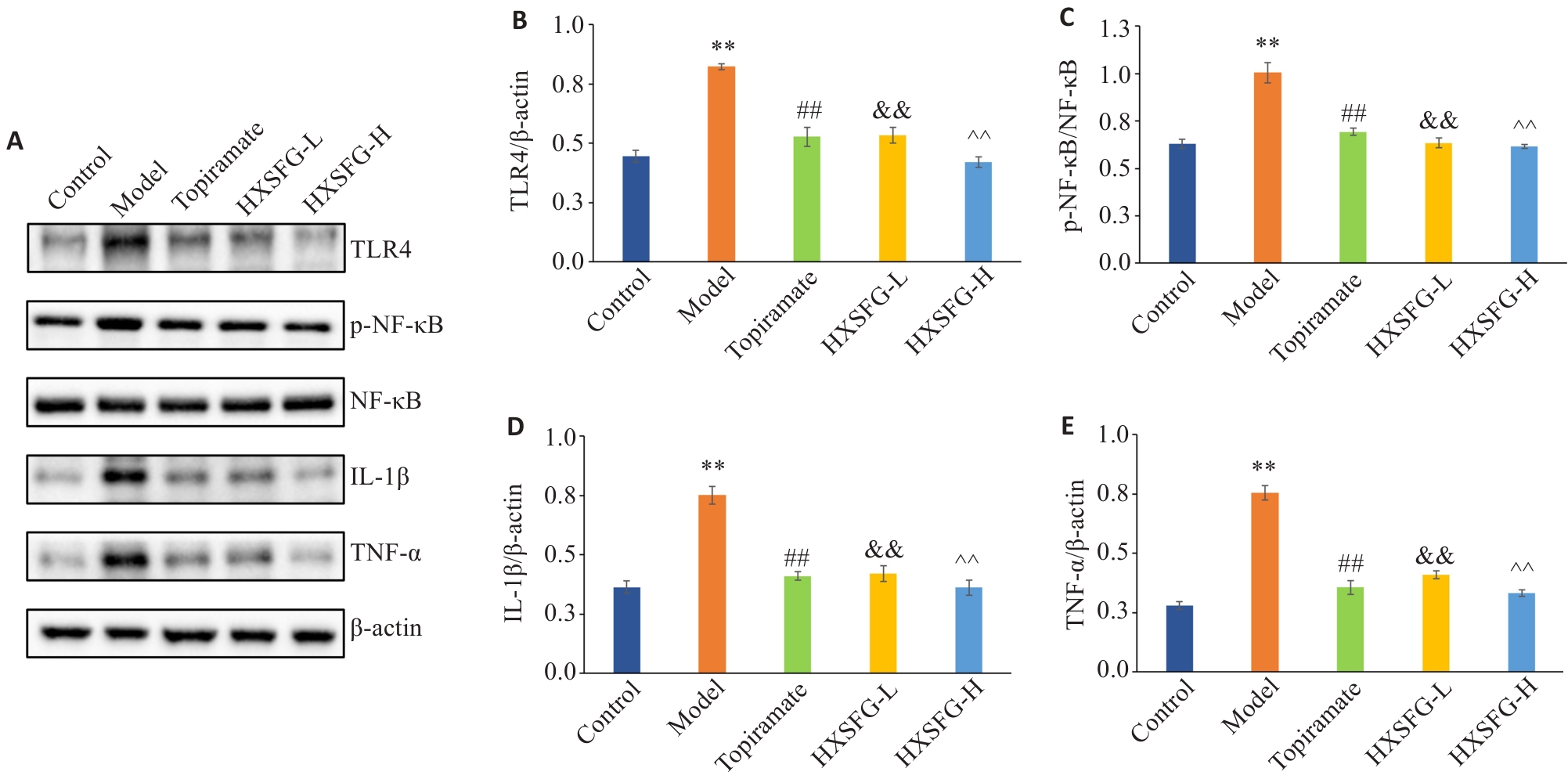
Fig. 6 Effects of HXSFG on the TLR4/NF-κB signaling pathway in the TNC region of mice with NTG-induced CM. A: Protein immunoblot images of TLR4, p-NF-κB, NF-κB, IL-1β, TNF-α expression. B: Quantitative analysis of TLR4 protein immunoblotting. C: Quantitative analysis of p-NF-κB/NF-κB protein immunoblotting. D: Quantitative analysis of IL-1β protein immunoblotting. E: Quantitative analysis of TNF-α protein immunoblotting (n=4). Data are presented as Mean±SE. Statistical analysis was performed using two-way ANOVA followed by Tukey's post hoc test. **P<0.01 vs Control group; ##P<0.01 vs Model group; &&P<0.01 vs Model group; ^^P<0.01 vs Model group.
| 1 | GBD 2021 Nervous System Disorders Collaborators. Global, regional, and national burden of disorders affecting the nervous system, 1990-2021: a systematic analysis for the Global Burden of Disease Study 2021[J]. Lancet Neurol, 2024, 23(4): 344-81. |
| 2 | Ashina M, Katsarava Z, Do TP, et al. Migraine: epidemiology and systems of care[J]. Lancet, 2021, 397(10283): 1485-95. |
| 3 | Steiner TJ, Stovner LJ. Global epidemiology of migraine and its implications for public health and health policy[J]. Nat Rev Neurol, 2023, 19(2): 109-17. |
| 4 | Andreou AP, Edvinsson L. Mechanisms of migraine as a chronic evolutive condition[J]. J Headache Pain, 2019, 20(1): 117. |
| 5 | May A, Schulte LH. Chronic migraine: risk factors, mechanisms and treatment[J]. Nat Rev Neurol, 2016, 12(8): 455-64. |
| 6 | Hovaguimian A, Roth J. Management of chronic migraine[J]. BMJ, 2022, 379: e067670. |
| 7 | Boyer N, Dallel R, Artola A, et al. General trigeminospinal central sensitization and impaired descending pain inhibitory controls contribute to migraine progression[J]. Pain, 2014, 155(7): 1196-205. |
| 8 | Volcheck MM, Graham SM, Fleming KC, et al. Central sensitization, chronic pain, and other symptoms: Better understanding, better management[J]. Cleve Clin J Med, 2023, 90(4): 245-54. |
| 9 | Thuraiaiyah J, Erritzøe-Jervild M, Al-Khazali HM, et al. The role of cytokines in migraine: a systematic review[J]. Cephalalgia, 2022, 42(14): 1565-88. |
| 10 | Kursun O, Yemisci M, van den Maagdenberg AMJM, et al. Migraine and neuroinflammation: the inflammasome perspective[J]. J Headache Pain, 2021, 22(1): 55. |
| 11 | Inoue K, Tsuda M. Microglia in neuropathic pain: cellular and molecular mechanisms and therapeutic potential[J]. Nat Rev Neurosci, 2018, 19(3): 138-52. |
| 12 | Liu L, Xu YT, Dai HM, et al. Dynorphin activation of kappa opioid receptor promotes microglial polarization toward M2 phenotype via TLR4/NF-κB pathway[J]. Cell Biosci, 2020, 10(1): 42. |
| 13 | Lu GS, Xiao SB, Meng FC, et al. AMPK activation attenuates central sensitization in a recurrent nitroglycerin-induced chronic migraine mouse model by promoting microglial M2-type polarization[J]. J Headache Pain, 2024, 25(1): 29. |
| 14 | Luo L, Liu M, Fan Y, et al. Intermittent Theta-burst stimulation improves motor function by inhibiting neuronal pyroptosis and regulating microglial polarization via TLR4/NFκB/NLRP3 sig-naling pathway in cerebral ischemic mice[J]. J Neuroinflammation, 2022, 19(1): 141. |
| 15 | Liu Q, Yan R, Wang L, et al. Alpha-asarone alleviates cutaneous hyperalgesia by inhibiting hyperexcitability and neurogenic inflammation via TLR4/NF‑κB/NLRP3 signaling pathway in a female chronic migraine rat model[J]. Neuropharmacology, 2024, 261: 110158. |
| 16 | Erdener ŞE, Kaya Z, Dalkara T. Parenchymal neuroinflammatory signaling and dural neurogenic inflammation in migraine[J]. J Headache Pain, 2021, 22(1): 138. |
| 17 | Chen H, Tang X, Li J, et al. IL-17 crosses the blood-brain barrier to trigger neuroinflammation: a novel mechanism in nitroglycerin-induced chronic migraine[J]. J Headache Pain, 2022, 23(1): 1. |
| 18 | Pijpers JA, Kies DA, van Zwet EW, et al. Cutaneous allodynia as predictor for treatment response in chronic migraine: a cohort study[J]. J Headache Pain, 2023, 24(1): 118. |
| 19 | 龙亚秋, 何文星, 李 华, 等. 陈宝田治疗头痛经验总结[J]. 中国中医基础医学杂志, 2016, 22(2): 213, 226. DOI: 10.3969/j.issn.2095-7246.2016.01.009 |
| 20 | 谢 炜, 洪 雨, 范穗强, 等. 偏头痛分型论治多中心临床观察及疗效分析[J]. 热带医学杂志, 2012, 12(3): 274-8. |
| 21 | 梁雯琳, 谢 炜, 洪 雨, 等. 活血疏风颗粒对偏头痛模型大鼠血浆SP、CGRP和脑干5-HT含量的影响[J]. 时珍国医国药, 2016, 27(12): 2882-4. |
| 22 | Zhang W, Zhang Y, Wang H, et al. Animal models of chronic migraine: from the bench to therapy[J]. Curr Pain Headache Rep, 2024, 28(11): 1123-33. |
| 23 | Al-Hassany L, Goadsby PJ, Danser AHJ, et al. Calcitonin gene-related peptide-targeting drugs for migraine: how pharmacology might inform treatment decisions[J]. Lancet Neurol, 2022, 21(3): 284-94. |
| 24 | Chou TM, Lee ZF, Wang SJ, et al. CGRP-dependent sensitization of PKC‑δ positive neurons in central amygdala mediates chronic migraine[J]. J Headache Pain, 2022, 23(1): 157. |
| 25 | Wu S, Ren X, Ren X, et al. A c-Fos activation map in nitroglycerin/levcromakalim-induced models of migraine[J]. J Headache Pain, 2022, 23(1): 128. |
| 26 | Ho TW, Edvinsson L, Goadsby PJ. CGRP and its receptors provide new insights into migraine pathophysiology[J]. Nat Rev Neurol, 2010, 6(10): 573-82. |
| 27 | Xiao SB, Lu GS, Liu JY, et al. Brain-wide mapping of c-Fos expression in nitroglycerin-induced models of migraine[J]. J Headache Pain, 2024, 25(1): 136. |
| 28 | Ferrari MD, Goadsby PJ, Burstein R, et al. Migraine[J]. Nat Rev Dis Primers, 2022, 8(1): 2. |
| 29 | Chen J, Cai Y, Wei D, et al. Formononetin inhibits neuroinflammation in BV2 microglia induced by glucose and oxygen deprivation reperfusion through TLR4/NF‑κB signaling pathway[J]. Brain Res, 2024, 1845: 149218. |
| 30 | Zhang LL, Wei W. Anti-inflammatory and immunoregulatory effects of paeoniflorin and total glucosides of paeony[J]. Pharmacol Ther, 2020, 207: 107452. |
| 31 | Foudah AI, Devi S, Alqarni MH, et al. Quercetin attenuates nitroglycerin-induced migraine headaches by inhibiting oxidative stress and inflammatory mediators[J]. Nutrients, 2022, 14(22): 4871. |
| [1] | Xinyuan CHEN, Chengting WU, Ruidi LI, Xueqin PAN, Yaodan ZHANG, Junyu TAO, Caizhi LIN. Shuangshu Decoction inhibits growth of gastric cancer cell xenografts by promoting cell ferroptosis via the P53/SLC7A11/GPX4 axis [J]. Journal of Southern Medical University, 2025, 45(7): 1363-1371. |
| [2] | Liming WANG, Hongrui CHEN, Yan DU, Peng ZHAO, Yujie WANG, Yange TIAN, Xinguang LIU, Jiansheng LI. Yiqi Zishen Formula ameliorates inflammation in mice with chronic obstructive pulmonary disease by inhibiting the PI3K/Akt/NF-κB signaling pathway [J]. Journal of Southern Medical University, 2025, 45(7): 1409-1422. |
| [3] | Yinfu ZHU, Yiran LI, Yi WANG, Yinger HUANG, Kunxiang GONG, Wenbo HAO, Lingling SUN. Therapeutic mechanism of hederagenin, an active component in Guizhi Fuling Pellets, against cervical cancer in nude mice [J]. Journal of Southern Medical University, 2025, 45(7): 1423-1433. |
| [4] | Lijun HE, Xiaofei CHEN, Chenxin YAN, Lin SHI. Inhibitory effect of Fuzheng Huaji Decoction against non-small cell lung cancer cells in vitro and the possible molecular mechanism [J]. Journal of Southern Medical University, 2025, 45(6): 1143-1152. |
| [5] | Guoyong LI, Renling LI, Yiting LIU, Hongxia KE, Jing LI, Xinhua WANG. Therapeutic mechanism of Arctium lappa extract for post-viral pneumonia pulmonary fibrosis: a metabolomics, network pharmacology analysis and experimental verification [J]. Journal of Southern Medical University, 2025, 45(6): 1185-1199. |
| [6] | Liping GUAN, Yan YAN, Xinyi LU, Zhifeng LI, Hui GAO, Dong CAO, Chenxi HOU, Jingyu ZENG, Xinyi LI, Yang ZHAO, Junjie WANG, Huilong FANG. Compound Centella asiatica formula alleviates Schistosoma japonicum-induced liver fibrosis in mice by inhibiting the inflammation-fibrosis cascade via regulating the TLR4/MyD88 pathway [J]. Journal of Southern Medical University, 2025, 45(6): 1307-1316. |
| [7] | Peipei TANG, Yong TAN, Yanyun YIN, Xiaowei NIE, Jingyu HUANG, Wenting ZUO, Yuling LI. Tiaozhou Ziyin recipe for treatment of premature ovarian insufficiency: efficacy, safety and mechanism [J]. Journal of Southern Medical University, 2025, 45(5): 929-941. |
| [8] | Niandong RAN, Jie LIU, Jian XU, Yongping ZHANG, Jiangtao GUO. n-butanol fraction of ethanol extract of Periploca forrestii Schltr.: its active components, targets and pathways for treating Alcheimer's disease in rats [J]. Journal of Southern Medical University, 2025, 45(4): 785-798. |
| [9] | Haonan¹ XU, Fang³ ZHANG, Yuying² HUANG, Qisheng⁴ YAO, Yueqin⁴ GUAN, Hao CHEN. Thesium chinense Turcz. alleviates antibiotic-associated diarrhea in mice by modulating gut microbiota structure and regulating the EGFR/PI3K/Akt signaling pathway [J]. Journal of Southern Medical University, 2025, 45(2): 285-295. |
| [10] | Junjie GAO, Kai YE, Jing WU. Quercetin inhibits proliferation and migration of clear cell renal cell carcinoma cells by regulating TP53 gene [J]. Journal of Southern Medical University, 2025, 45(2): 313-321. |
| [11] | Ying LIU, Borui LI, Yongcai LI, Lubo CHANG, Jiao WANG, Lin YANG, Yonggang YAN, Kai QV, Jiping LIU, Gang ZHANG, Xia SHEN. Jiawei Xiaoyao Pills improves depression-like behavior in rats by regulating neurotransmitters, inhibiting inflammation and oxidation and modulating intestinal flora [J]. Journal of Southern Medical University, 2025, 45(2): 347-358. |
| [12] | Qiao CHU, Xiaona WANG, Jiaying XU, Huilin PENG, Yulin ZHAO, Jing ZHANG, Guoyu LU, Kai WANG. Pulsatilla saponin D inhibits invasion and metastasis of triple-negative breast cancer cells through multiple targets and pathways [J]. Journal of Southern Medical University, 2025, 45(1): 150-161. |
| [13] | Xiupeng LONG, Shun TAO, Shen YANG, Suyun LI, Libing RAO, Li LI, Zhe ZHANG. Quercetin improves heart failure by inhibiting cardiomyocyte apoptosis via suppressing the MAPK signaling pathway [J]. Journal of Southern Medical University, 2025, 45(1): 187-196. |
| [14] | Meng XU, Lina CHEN, Jinyu WU, Lili LIU, Mei SHI, Hao ZHOU, Guoliang ZHANG. Mechanism of Hedyotis diffusa-Scutellaria barbata D. Don for treatment of primary liver cancer: analysis with network pharmacology, molecular docking and in vitro validation [J]. Journal of Southern Medical University, 2025, 45(1): 80-89. |
| [15] | Qing LIU, Jing LIU, Yihang ZHENG, Jin LEI, Jianhua HUANG, Siyu LIU, Fang LIU, Qunlong PENG, Yuanfang ZHANG, Junjie WANG, Yujuan LI. Quercetin mediates the therapeutic effect of Centella asiatica on psoriasis by regulating STAT3 phosphorylation to inhibit the IL-23/IL-17A axis [J]. Journal of Southern Medical University, 2025, 45(1): 90-99. |
| Viewed | ||||||
|
Full text |
|
|||||
|
Abstract |
|
|||||